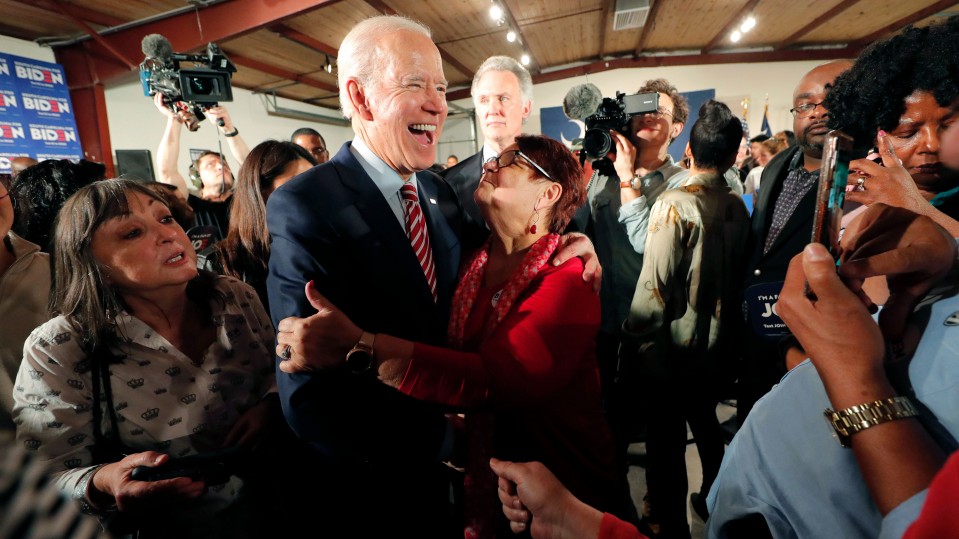

Election 2020
How Biden’s climate plan stacks up to Bernie’s
He doesn’t plan to spend nearly as much, but he’s striving to build a broader coalition.

Election 2020: The 2020 US presidential election is a critical moment for politics, technology and policy-making. We cover everything from secure voting systems and disinformation campaigns to the future of jobs and plans to combat climate change.
The Super Tuesday primaries all but narrowed the Democratic presidential field to a two-person race, inflaming a heated battle between the party’s moderate and progressive wings.
The differences are particularly stark on the issue of climate change, where the front-runners—former vice president Joe Biden and Senator Bernie Sanders—have sharply contrasting visions of what’s required and achievable.
Biden has strived to claim the “middle ground” on the issue from the start, hoping to win over environmentalists as well as blue-collar workers, as Reuters first noted. In a nod to the left, his climate plan adopted (or perhaps co-opted) some of the populist language of the Green New Deal, which he name-checked as a “crucial framework.” But his time lines for cutting greenhouse-gas emissions are far looser than the ones Sanders is calling for, stating only that the economy as a whole should reach “net zero” emissions by 2050. And he’s proposing about a tenth of the amount of federal spending, at $1.7 trillion over 10 years compared with more than $16 trillion.
Biden also wants to use a broader mix of tools in the transition, including developing advanced nuclear power plant, and technologies that can capture carbon dioxide from fossil-fuel plants.
Meanwhile, Sanders wants all of the nation’s power sector and ground transportation to run on renewable sources like wind and solar within 10 years. He rejects carbon capture because it could extend our reliance on fossil fuels, and he wants to prevent new nuclear power plants and begin shutting down existing ones. The senator also intends to ban fracking, end the import and export of oil and gas, and launch civil if not criminal legal investigations into the fossil-fuel industry. (See our full analysis of Sanders’s climate plan here.)
Like most candidates in the field, Biden pledged to rejoin the Paris agreement, and work with world leaders to boost goals for emissions cuts. In addition, he says he’ll push to end fossil-fuel subsidies worldwide.
Also like others, he’s betting big on the promise of innovation, pledging to spend $400 billion over 10 years and create a new agency, ARPA-C, to accelerate research on small modular nuclear reactors, carbon capture, grid-scale energy storage, and lower-emissions methods for producing steel, cement, hydrogen, and food.
Here are Biden’s positions on other key energy issues:
Electricity: Unlike most of his Democratic rivals, Biden didn’t announce a target date for eliminating emissions from the electricity sector. He only says that all sectors should be carbon free by midcentury, and that he intends to enact legislation in his first year that will create “an enforcement mechanism” with “milestone targets” by 2025.
Vehicles: Biden’s transportation plans are also light on deadlines and funding commitments. But he wants to accelerate the shift to cleaner cars and trucks by restoring tax credits for electric vehicles, building out half a million charging stations around the nation, and enacting stricter vehicle mileage standards. He also wants to find ways to encourage the development of sustainable fuels for aircraft, reduce urban sprawl, and increase public transit and high-speed rail systems.
Carbon price: Biden’s campaign told the Washington Post he supports setting a price on carbon, either through a tax or a cap-and-trade program.
Fracking: Unlike both Sanders and Warren, Biden isn’t calling for a ban on fracking, a drilling method widely used for natural-gas and oil extraction. He does support “aggressive methane pollution limits” and other tighter regulations on the sector.
Nuclear: See above.
Feasibility and risks: By staking out a middle position on climate issues, Biden may be appealing to a broader coalition, including labor unions, which could be key for building necessary political support.
Nuclear and carbon removal may be crucial tools in cutting emissions as rapidly and affordably as possible, including from the industrial sector. And by steering clear of fracking bans, Biden would avoid some very divisive battles in key swing states, like Pennsylvania and Ohio, that rely heavily on the natural-gas industry.
But Republicans will blanch even at a $1.7 trillion federal spending package. The fossil-fuel sector will still push back against demands to eventually cut emissions or add expensive systems to capture them. And some climate advocacy groups have already blasted Biden’s plans for not going nearly far enough. That may well dampen enthusiasm for his candidacy, particularly among the rising share of young voters who see climate change as a “major threat” and reject any whiff of incrementalism.